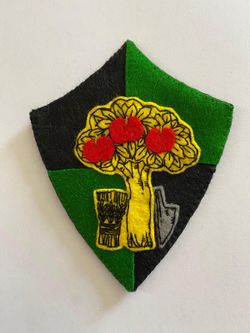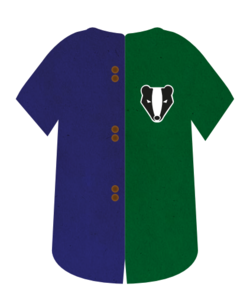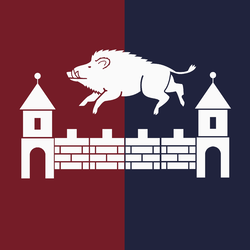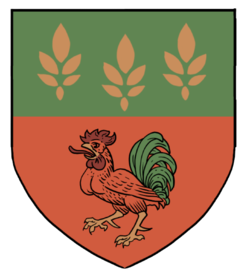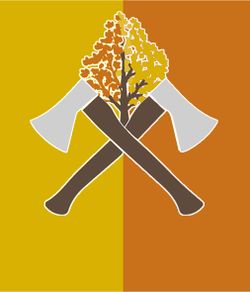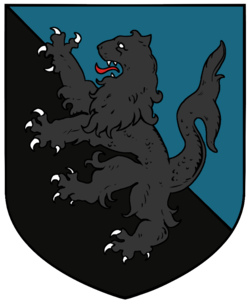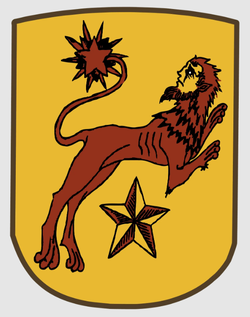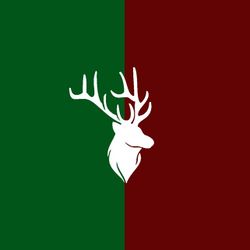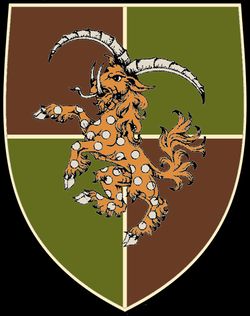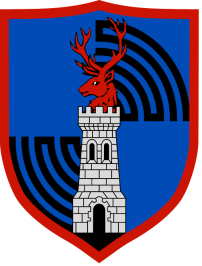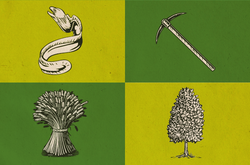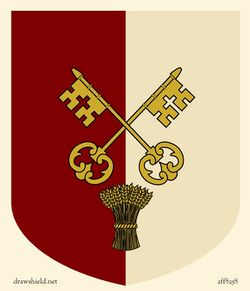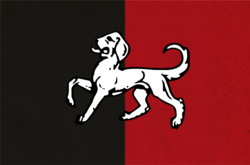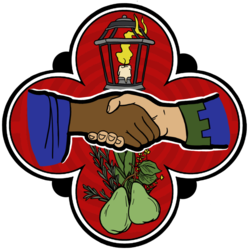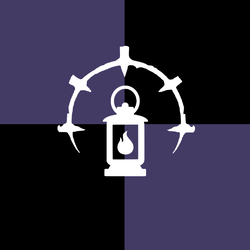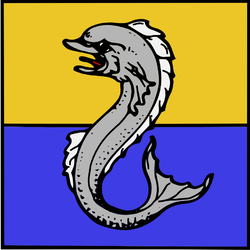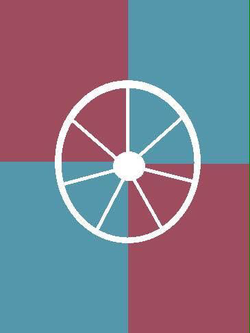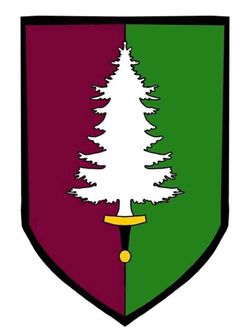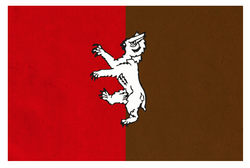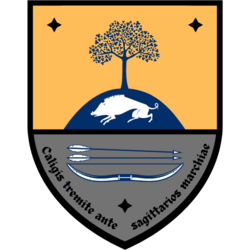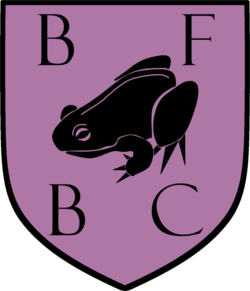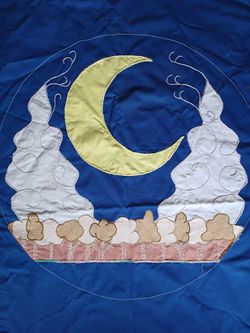The Marches groups
Overview
There are many important households, landskeeper circles, market towns, and monasteries in the Marches. Despite the number, only a comparative handful are involved in the affairs of the Empire (that is, attend the seasonal summits at Anvil). Their influence can wax and wane, and involvement in Imperial affairs is not always a reflection of their prominence within the nation itself. This page presents in-character information about the groups that attend, or have attended, Anvil — the kind of thing that someone who asked about them might uncover from talking to their peers. In each case, the information is provided by the players and edited before being put on the wiki.
The majority of groups listed here are made up of player-characters. You should not create a character who is part of a group, or has personal history with one, without first clearing it with the appropriate players. You should also check before including other players' groups in your background. The background team are unlikely to approve a background that significantly impacts or involves another player character group without their permission. There are also a handful of prominent NPC groups included for completeness, but they are not intended for use by player characters.
Households and Monasteries
The households and monasteries of the Marches wield the lion's share of political power in the nation, because they control the largest amount of farmland.
Households of Upwold
Applewood Levy
- Location: Applewood, Stock March
- Livery: Black and green
- Symbol: Full apple tree
- Steward: Tilda Reaper
The Levy is a group of allied households who live, farm, and work in the Applewood northern Stock March. Their farms are scattered around the village of Applewood on the road between Stockland and Moot in Hahnmark, mostly on the west side of the road. Applewood is known for its abundant crop of apples, and for the orchard graveyard that lies to the west of the village where generations of Applewood residents rest beneath the soil.
Applewood had regular problems with the Feni in the past. Indeed, two months before the Winter Solstice of 376YE much of the village was burned by a major raid which saw several local households forming a levy to act as a unified force and defend the area against future threats. The smaller households merged to form a single household under a single steward who also oversees the Applewood Arms in Anvil. In recent years many of its members have formed a substantial military unit presence, known as the apple corps, led by whoever is the senior captain; to secure the Applewood itself and extend their help to the rest of the marches when called on.
House Balston
- Location: Birchland
- Livery: Blue and green
- Motto: Rise Again
- Symbol: Rampant badger
- Steward: William Hooke Jr
The Balston Household originated from a group of trappers and gamekeepers during the March from Dawn. Their first leader, James Balston, gathered support as they marched west, pursued by the Knights and Earls - and was eventually caught and executed at Brock's Toll - an incident from which the Balstons believe the bridge takes its name. After his death, James' daughters; Hester, Ann and Lily Balston established the settlement of Lambrook, which has been an influential presence in Birchland ever since.
The Balstons take in Pride a tradition of hard-bitten stubbornness in times of war. The household claims to have been the last non-Mournwolders to leave Sarcombe during the territory's fall to the Jotun in 349YE - covering an Imperial retreat which cost the Household's battalion dearly. After some years attending Anvil, the Household again suffered heavy losses when ill-fated fights through the Sentinel Gate saw a number of its members fall. Those who survived however have worked hard to see their proud household rise and thrive again. For these reasons, the members of the Balston household have earned a reputation for sanguine ferocity in the eyes of both their allies and rivals. If not fighting in their iconic blue and green livery, "The Badgers" as they are often known can be found making merry - or making trouble - across Anvil.
House Boarbridge
- Location: Birchland,
- Livery: Burgundy and navy
- Motto: Cross us if you dare
- Symbol: White boar above a white bridge, white towers
- Steward: Nana Boarbridge
House Boarbridge was formed after the cousins' war. A group of yeofolk made their farms among the dense trees of Birchland. According to local stories the fertile marshland over which the bridge now stands was once home to a dire boar of gigantic proportions. Taking this as a sign of Prosperity, the newly assembled household set to task to clear the area. So stubborn was this boar to move from their home during the initial settling of the area that the yeofolk felt an instant kinship with it. They felt that it embodied the best of Marcher values. The boar was allowed to stay, the yeofolk instead choosing to build their settlement around and bridge over the boar’s home.
The wealth and influence of the household has recently taken an upturn after Lorenzo’s Deep Pockets, as it's known, opened in Spring 381YE. There has been an increase in travellers being forced to go through the forests of Birchland due to the sinkhole, seeing more and more traffic making its way over the bridge on their way west or east. Seeing previously unknown prosperity, and having a larger number of farms than ever before means that the household is finding itself more and more involved in marcher politics and wider Imperial affairs.
The household itself is comprised mostly of yeofolk, with a strong tradition of beaters, and a number of threshers.
Cockscroft Farm
- Location: The Heath
- Livery: Orange and green
- Motto: All Yield
- Symbol: Crowing rooster beneath three sheaves of wheat
- Steward: John Fisher
The Cockscroft Farm is a collection of farms in Upwold, sitting just above the border to Mournwold. Though the Heath isn’t best suited for agriculture, the many ritualists on the farm work together in a coven to ensure that their harvests remain prosperous, helped along by the circle of standing stones that enclose their land. They pride themselves on hard work and efficiency, using their graft and magic to grow crops with the most bountiful yield possible.
The household and its farm are young, having been started by a handful of farmers less than a decade ago. Still, they are a close family with firm values that are built on their belief in the Way and Marcher traditions. In the local towns, the household has gained a reputation for their bountiful farms and dogged determination. That, and the fact that a lot of them are called John.
House Dunholt
- Location: Upwold, Stock March
- Livery: Mustard Yellow & Burnt Orange
- Symbol: Crossed axes below an autumn oak
- Steward: Alfred Dunholt
Perched atop a flowery hillock in Stock March is the ancestral home of House Dunholt. A site as old as its nation, whose founders had slipped away into the ranks of passing rebels and took with them an eternal aversion to authority. An aversion which would lead to their decline.
At the outbreak of the Cousins War, House Dunholt was a major producer of barley and their steward Adam “Two Fingers” Dunholt was a very vocal opponent to the Empire. They pledged the household to the independence of the Marches, mustering a force of archers to meet those encamped towards Hepton Bridge. They never made the journey there, ambushed upon the way. Nearly all of them were fought to the death, leaving few left to tend the barley. The great fields were converted into a graveyard orchard and those who remained began anew.
Now House Dunholt is known more for its cider and mead than barley - most often trading in Stockland. Preparing the more popular inns and pubs for those out-of-towners who would turn their nose up at the local ale.
The Greaye Hunt Merchants
- Location: Stockmarch, Upwold
- Livery: Blue and Black
- Symbol: The Greaye Rampant
- Motto: From ashes we grow, water our road, coin our bill, and contract our bow.
- Steward: Merriweather Greaye
The Greaye Hunt Merchants were formed after the tumultuous Winter of 384YE. Various parties had come into poor luck with fires, homelessness and other rough turns of fortune, and in their time of need, close friends offered their home beside the river as a temporary respite.
After spending time beside the waterways, tending to their wounds, several business opportunities were discovered, allowing for the group to flourish anew.
Friendships were strengthened over trade and food, and the parties eventually decided to establish themselves as a new household. They now try to act as a trade hub, a financial centre for the local region, encouraging Marcher market towns to reach further and gain access to new goods from across the Empire.
House Guildenstern
- Location: Stockmarch, Upwold
- Livery: Burgundy and Bottle Green.
- Symbol: Manticore leaping over a star
House Guildenstern is one of the many houses of the Marches that traces its roots back to the original exodus from Dawn. The woodlands and hills around the Guildenstern estate are particularly wild and home to dangerous and according to stories, “otherworldly” entities. Still to this day opting to use larger swords than billhooks. They largely kept to themselves, becoming involved in Marcher politics only during the Cousin's War. House Guildenstern still boasts that one of their household was present when the Empress accepted the Marches as part of her Empire.
Due to their knowledge of "strange things" and a general reputation for being "not quite right" House Guildenstern has connections with the thresher movement as well as many Hedge-mages, fighting against the sorcerers serving Alderei the Fair as part of Tom Drake's retinue in the army that would become the Drakes. House Guildenstern continues their involvement in the more magical aspects of the Marches and the Empire, in many cases aiming to treat with eternals. Their banner is a manticore leaping over a faltering gold star as a nod to their traditional way of thinking (although some link it to an ancient story of the House before the March, another sign that the house is a little peculiar by Marcher standards, their banner being almost Dawnish in its outré imagery). The Guildenstern are very aggressive towards the Feni. They are a part of the Unbound Union
House Hartell
- Location: Hartford, Ashbrook, Upwold
- Livery and Symbol: Dark green and burgundy with a white stag head badge
- Motto: Through the mud and the blood to the green fields beyond
- Steward: Edmund Forster
Despite being an old household whose chronicles trace farther back than the March of Succession, other Marchers do not particularly revere the Hartell like they might King's Stoke, Talbots or Grey Shanks. The household itself takes its name from the white stag their hunters pursued through Miaren, which according to their folklore, led them to be the first settlers to emerge from the woods of Birchland.
Hartford, a village within spitting distance of the River Meade, is known for its thriving tanning and leatherworking industry due to its abundant access to birch bark and beggar’s lye from neighbouring Birchland.
Their yeofolk have customarily served with the Bounders from inception and take pride in its reputation for ruthless pursuit. Those who do not go on to become beaters or retire to a well-earned farm maintain the proud tradition of service as sentries at the fortification of East Guard in Birchland.
They often come accompanied by the roaming bar known as the Black Rat - named after the first patron of its cider.
House Kinahan
- Location: Tower March
- Livery: Forest green, walnut, and carrot orange
- Motto: Through the mud and the blood to the green fields beyond
- Symbol: Rearing Yale
- Steward: Rantalot Kinahan
The lands of House Kinahan are comprised of open fields found nestled in amongst the dense forests of Towers March. Clinging onto its traditions it has refused to embrace the change of becoming a part of the heavy forestry business, instead making income farming lower valued crops and only cutting down trees for the occasional woodworking to help ends meet.
Although having been everpresent through the history of the Marches, the Kinahans have only recently begun to hold higher aspirations and reach out. They are best known for their absolute loyalty to the household, unnecessary hoarding of food and their strange distaste for all orcs.
Pickham Monastery
- Location: Tower March, between King's Stoke and the Eastern Guard
- Colours Blue and Red
- Motto: If you want to hold the land, first build a tower
- Symbol: Blue, a Silver Tower crowned by a Red Stag's Head
“If you want to hold the land, first build a tower” speaks the proverb, and it speaks truly. The monks of Pickham Monastery live by a Rule that demands readiness for action, simple living, and watchfulness in all things. The monastery’s founder was Major Joshua Benson, Exemplar of Vigilance. A sharp-eyed sentry, he foiled a Dawnish raid on the village of Pickham, and became a renowned local priest of Vigilance. His followers once claimed only Pickham's run-down peel tower, but Pickham Monastery grew to dwarf its namesake village.
The monks have long supported the beaters and threshers of Upwold. Their library is stocked as much toward practical Vigilance as religious matters, and the monks themselves often train as intelligencers, ritualists, or exorcists. They are known for their careful study and cunning use of hearth magics, folklore and curses. A necessary expertise, as the Monastery’s lands have a reputation for hauntings and strange events around Wassail.
Siblings of Pickham often nurture grudges towards fools who act without thought. Dubious assumptions and shifty arguments are seen as falsehoods to be sought out and overturned by the faithful. As such, the siblings of Pickham are as dogged in the pursuit of Clemency or acquittal for the Virtuous as they are in the condemnation of criminals.
Smuddy Russets
- Location: Birchland, Upwold
- Livery: Green and white
- Symbol: The rune Rhyv on an apple
- Steward: Nancy Smudd
The Smuddy Russets are apple farmers through and through. The house itself is a relatively small one now compared to what it once was, due to fighting for the empire or family tragedies. Living in Upwold, in Birchland, the family was shaken when their house and farm partially fell into “The Bloody Great Hole”. The family quickly acted to stop the house falling in, roping parts of it to the ground and reinforcing others. With this, the Smudds have been working to rebuild ever since and have continued to grow apples in what is left of their orchard as well as ‘branching’ out with having a sideline in the pig business, bar their pet mini-pig, Bacon. He’s special.
As well as growing apples, the Smudds work to help the armies of the Empire by acting as physicks in any battles they are a part of, making sure that any Marcher that falls is picked back up and gets back home. With green and white tabards, the Smudds, with the rune of Rhyv on their banner to show how important blood is, strive to keep the land they live on and their friends and family safe and strong in ever changing times.
Households of Mitwold
House Crossland
- Location: Near Hay, Mitwold
- Livery: Yellow and green
- Motto: Life's short, play in the dirt
- Symbol:Quartered Yellow/Green with each quarter showing a pickaxe, eel, apple tree and wheat sheaf
- Steward: Marcus Crossland
The Crosslands come from different backgrounds and professions such as mining, farming, and growing herbs, but it is their common interest in improving the Empire that has brought them together.
Their shared values of hospitality and support for newcomers to the region have inspired them to band together and form a close-knit group. They take pride in making sure that visitors to the summits of Anvil, especially those who are visiting for the first time, feel welcome and supported.
This group strive to be known for their generous and collaborative nature. They are always willing to lend a helping hand to those in need and work together to make the land and the Empire a better place for everyone. Whether it's organizing events, tending to the land, or volunteering their time for community projects, the household is dedicated to improving the world around them.
House Garamond
- Location: Mead, Mitwold
- Livery: per pale Sanguine and bisque in
- Motto: That which is yet to be found we shall seek.
- Symbol: fess point a pair of keys yellow-ochre in nombril a corn sheaf yellow-ochre.
- Steward: Leof of Mead.
House Garamond is situated in one of the oldest buildings in Meade town centre and can trace their roots back to some of the oldest families of Dawn. The crumbling vaults of House Garamond were once used by the settlers of Mead to store their coin and valuables as well as the irreplaceable historical possessions which House Garamond had accumulated. Eventually folk trusted the Talbots over House Garamond and their dilapidating vaults to store their coin resulting in a shift of the House’s income to rely more on its crops and breweries. The artifacts stored in many of the Garamond vaults eventually decayed or were buried as the old vaults collapsed, leaving only a handful that are now proudly displayed for all to see.
To this day, yeomen of House Garamond still have a particular interest in preserving ancient history and can be found travelling from town to town in search of interesting objects of historical importance and educating visitors on the history of their proud remaining artifacts. The keys depicted in their livery once represented the security of their vaults though now only two remain in service, they are considered by House Garamond to be one of the most secure places in Mitwold.
The Hotspurs
- Location: Meade March
- Livery: Black and blue
- Motto: De Terra Fortes (from the earth, the strong)
- Symbol: A four pointed compass on a background of blue and black
- Steward: Gerald Burberry
Traditionally based around the docks of Meade, the household has holdings on a series of small craggy isles known as the ‘Stoney Isles’ within the delta of the river Meade. This allows the house to keep a watchful eye on the comings and goings of the various barges and ships making their way to and from the docks and permits the house’s fleets to venture out into the wider waterways of the Empire.
Household legend tells of the youths coalescing around the docks many years ago, carrying out odd jobs for anyone willing to pay and "persuading" those who are unwilling. This public service has led to a somewhat rough and ready reputation, aided further by the continuing recruitment from the docksides and dark alleys of Meade.
As business has grown increasingly lucrative the Household's primary concern has become the management and transport of goods coming through the docks from across the waters of Westmere.
The Marcher Tea Company
- Location: Meade March
- Livery: Black and green
- Motto: Irrita Me; Invenies Quid Valeam
- Symbol: A badger rampant on a green field
- Steward: Chestnut
The Marcher Tea Company is something of an institution in Meade and can trace their distant roots back to the Balstons of Upwold.
Once a proud trade dynasty with roots across the Marches, years of war against the Jotun and the loss of the Mourn fractured the trade ties built carefully over so many years. At the head of their new steward the Tea Company seeks to reclaim its position as one of the premier trading Household and caravans laden with exotic teas from across the Empire are an increasingly common sight in Meade.
The Talbots of Hay
- Location: Golden Downs
- Livery: Red & Black
- Motto: Fort et Fidelis (Strength and Loyalty)
- Symbol: Passant white hound
- Steward: Hardulph Talbot
The Talbots were originally a noble house in service to House Gauvain. They created a shock wave in Dawnish society when they joined the Yeomen’s' revolt that subsequently led to the creation of the Marches nation.
Since the foundation of the Marches the Talbots have constantly sought to preserve the integrity of the nation against all aggressors, proving stalwart in the defence of the Marches during the many conflicts with Dawn and other bloody engagements. Despite their desire for a strong and independent Marches the Talbots recognised that incorporation into the expanding empire was inevitable and were one of the main proponents for unification. That said, the Talbots very much view themselves as Marches first. They recognise the importance of preserving the Empire but are keen to see the Marches and their Household prosper from this relationship.
To maintain their power, the Talbot are especially keen to invest in and control land in the Mitwold, often binding yeomen to their cause through negotiations and subsequent indentures. In addition, they have maintained a legacy for the quality of their blacksmiths and count several amongst their number. Ever since the fall of the Mournwold the Talbots have helped maintain the garrison at Fenrose keep with money, supplies and on occasion soldiers. Several prominent Talbots have served there as a rite of passage, turning errant youths into hardened warriors and effective leaders.
The Talbots of Meade
- Location: Meade Downs
- Livery: Red & Black
- Motto: Fort et Fidelis (Faithful and Strong)
- Symbol: Passant white hound
- Steward: Edward Talbot
The ancient House of Talbot were once the seneschals of the De Gauvain noble house in Dawn. When they made the decision to March with the other yeomen families they brought with them not only military might but the administrative skills needed to run a successful household. Taking lands in Mitwold, they eventually sided with the First Empress in the Cousins War, being present at the bloody battle of Hepton Bridge - they claim it was their forces that took the bridge itself.
The Talbots are well-known as landowners and manage well-run estates. This business sense has led them over time to be entrusted with the coin of other houses, using it to buy the stores their neighbours needed. This allowed, over time, the household to accumulate a vast wealth. Eventually they became a powerful household in Mitwold, especially around the trade centres of Meade and Hay. They have extensive properties in Meade but the seat of power for the house is the fortified Talbot Manor on the Meade Downs, situated in acres of sheep grazing land, from which their wool and subsequent wealth is harvested.
The household's animal heraldic symbol being the loyal hound, the white dog of Talbot. Loyalty is the virtue prized highest amongst the Talbots. The family motto “Fort et Fidelis”, which translates to “Faithful and Strong” in one of the Asavean dialects, echoes this sentiment. Although many of them prefer the unofficial motto “Never Knowingly Under Cater”, which is particularly popular around household gatherings and has yet to be proven wrong.
Households of Bregasland
Barrowby Abbey
- Location: The Rushes
- Motto: Hand Proffered, Lantern Lit
- Symbol: Clasped Hands, Lantern, Herbs and Pears set within a Quatrefoil
Barrowby Abbey was originally founded by local Marcher priests working side by side with pilgrims from Highguard in the aftermath of the Cousin’s War. The abbey's mission is to attempt to provide a source of spiritual guidance that exists outside of the grudges and squabbles commonly found between and within Bregasland households, with a focus on the virtues of Loyalty and Vigilance.
The abbey itself is built on top of one of three barrows, ancient burial mounds that have stood out from the surrounding fens since before the first Marchers settled in The Rushes. The second barrow, so low and sunken that it is prone to flooding, bears a small herb garden and an orchard that sprawls out into the surrounding wetland. The third barrow, by far the largest, lays bare. Eerie stories about the third barrow have been passed down in hushed tones by generations of lay Marchers, but such tales have never been acknowledged by the monks of Barrowby.
The daily work of the monks consists of tending their lands, distributing herbs and produce to their congregants across northern Rushes and southern Ottermire, and delivering sermons, shriving and the traditional funeral rites of Barrowby Abbey.
The Black Vigil
- Location: Near Gravenmarch
- Livery: Quartered Black and Purple
- Motto: A Lantern Lit, a Shadow Felled, a Debt Fulfilled.
- Symbol: Barbed Crescent Surrounding a Lit Lantern
- Steward: Gideon of Graven Rock
Across the marshes of Bregasland, the lanterns of the Black Vigil can be seen cutting through the dark as they patrol the fens and guard against encroaching threats.
Unlike many houses of the Marches, the Black Vigil’s ancestry does not trace back to Dawn. Its founding members come from Kallavesa, Tassato and the heart of Bregasland itself. They are warriors, brewers, mummers - vagabonds all.
Each, in their own way, were without guidance before being brought together by Gideon of Graven Rock and given purpose in hunting monsters across the shadowed recesses of the world. A kinship grew, and now through the fog and the fens of Bregasland they come, each member equipped with a lantern to always be a light in dark places. The lanterns' importance and what it represents is proudly displayed on their livery. The Black Vigil believes that ‘monster is a state of mind', so for those who behave monstrously, be they beast, barbarian or Imperial, the hunt is on.
As highly skilled fighters The Black Vigil frequently offer their services as mercenaries, guards and enforcers, to any with coin who may require their aid. The Vigil values respect highly, and for those who have earned their respect they will drink, fight, and share in revelry with until their lanterns burn out.
With their lanterns lit, shadows will fall, and all debts will be fulfilled.
House Elver
- Location: Northeast of Greywater
- Livery: Mustard and Azure with Eel Rampant
- Motto: The water sustains me without even trying. The water can't drown me, I'm done with my dying
- Steward: Dick Elver
Most of the early history of house Elver is lost but according to their own stories they were part of the first wave of households to march from Dawn. However, instead of marching on foot they spent most of their time on small boats following rivers and streams until finally arriving in Bregasland on a small jutting of land east of Greywater on the coast of Westmere. During the Cousin’s War the household was reluctant to pick a side but eventually sent a small retinue to fight to join the Empire.
In recent years, the household has pursued a quieter life of farming eels, keeping to themselves and avoiding involvement in wider Bregasland or Marcher politics, choosing to pursue artistic endeavours with art and music being strongly encouraged alongside eel farming amongst the household.
During the recent invasion of Mathilda Fisher and her Jotun allies the household had to re-assess its non-political status and now takes an active part in the fight for Bregasland freedom and actively engages in the politics of Anvil.
House Greywater
- Location: Southern North Fens
- Livery: Drab gray and olive
- Motto: We remain
- Steward: Margery Greywater
House Greywater came to recent prominence following the conquest of Bregasland by the Jotun. A household from North Fens, they have a chequered reputation in the Marches, even by the standards of Bregasland. "Poacher" is a dangerous word to bandy around... but it's commonly said of the Greywaters that "they don't own a lot of land of their own, but they sure know a lot about other peoples..." What can't be denied is that they're skilful archers and they know the Bregasland marshes like the backs of their hands. They were also known to hate Mathilda Fisher, so-called Steward of Bregasland. Apparently, some old, old grudge exists between the Greywaters and the Fishers involving a basket of stolen eels that predates the founding of the Empire. They refused to take the Jotun conquest of Bregasland lying down - not only did they actively resist the invaders, they weren't quiet about it either. With a little assistance from Marcher heroes, they took to the Grey Fens, working with the Strong Reeds to resist the would-be conquerors. From hidden camps they mounted a guerrilla campaign against Fisher and her orc allies, using the cover of the marshes to make it impossible for the Jotun to bring them to heel. They helped the Strong Reeds lay low, granting significant advantages. They continued to bedevil the invaders, and fought bravely to drive them out of the territory.
NPC Group: The Greywaters are an NPC group; you cannot create a player character who is a member of the Greywaters.
House Wheelwright
- Location: Near the Gullet
- Livery: Claret and Blue
- Symbol: Seven-spoked wheel
- Steward: Reg Wheelwright
House Wheelwright have a small plot of land near the Gullet. Originally just the Wheelwright family lived here with some farm hands, now this includes a few other families that have married in and taken a field as their own. The land is mostly used to raise small livestock that are able to thrive in the conditions. There is also a small church built next to the main farm house. All members of the Wheelwright household or attached church are encouraged to wear imagery of a seven spoked cart wheel. This hails back to the founder of the House, while also acknowledging the seven virtues.
House Wheelwright has lived here since their founder, George Wheelwright, bought the land from an old widow. Having always dreamed of a life outside of the town he grew up in, George didn't question the fantastic price, ending up right in the edge of Jotun territory.
As the name suggests, Wheelwrights like to make things, although there is more demand for mill wheels than the cart wheels they were originally named for. Various members of House Wheelwright have been seen in Anvil, including the steward, Reg, when he has the chance. When Reg is unable to make meets at Anvil, his sister Rosemary speaks for the Household.
House Wheelwright claims links to House Fenner, due to an aunt marrying into House Fenner.
Households of the Mournwold
Boon County
- Location: Boon County, Ore Hills
- Livery: A pickaxe overlaying the rune Feresh on a brown and beige field
- Motto: Our hills remain
- Steward: Jedediah ‘Jed’ Boon
Boon County is a large portion of land, deep in the Ore Hills. Made up almost entirely of miners, the Boon County Miners are technically called ‘House Boon’ but choose to steer away from this due to its association with farming households. They are a reclusive lot, deeply entrenched in mining tradition, such as burying their dead by lowering them down a burial mineshaft. They have a notable briar lineage and are zealously dedicated to Pride; their insular nature has left them with a distinct Ore Hills accent. Their former Steward, Ezekiel ‘Zeke’ Boon, was executed as a ringleader of the Ore Hills Rebellion in 326YE.
The Boon County Miners were devastated by the Jotun occupation. Those who survived the initial battles refused to leave, choosing to remain on their land due to their Pride; they would rather work their mines as slaves than be ousted. They attempted several revolts during this time, none of which were successful. The lengthy occupation and subsequent Imperial curses further decimated the Boons; when the Mourn was freed, Boon County began to open back up to the Empire. They remain staunchly religious, dedicated to Pride, and have renewed their push to get miners the right to vote in the Marches.
Copperhill Monastery
- Location: Greensward
- Colours: Grey and Red
- Symbol: Prancing Cockerel
- Leader: Abbott Thomas Arch
Copperhill Monastery is dedicated to the virtue of Pride though all virtues are practiced here. The abbey located between two hills in the Greensward in a region with a long tradition of copper mining. The monks have a tradition of taking in people with lineage who have nowhere else to go, and a result the population of Copperhill are mostly lineaged. With the war in the Mourn, Copperhill was destroyed but they are working to rebuild and to restore the Pride and Prosperity of the Greensward.
House Drayton
- Location: Freemoor and Graven March
- Livery: Black (for the peat), crimson (for the herbs)
- Motto: From dirt to stream to river
- Symbol: A Duck Sinister
- Steward: Nathaniel Drayton
House Drayton started its life in Freemoor, struggling to cope with scrubby farmland. Several winters were survived by trading skills and herbs picked from the local scrubland of their neighbours. As the years passed, trading became more important to the family. By the time of the Jotun occupation the family had adopted a non-traditional lifestyle living aboard several small river craft, farming the stream banks for herbs and collecting flotsam for trade. They moved much of this to the family members who had moved to Graven March. With the approach of the Jotun cutting off trade and being unable to sustain themselves by staying stationary, the Draytons were some of those who left the Mourn. Those at Graven March established a business trading in herbs and other resources - the Wanderin' Shop - that moved around, even as far as Anvil at times. The shop has a reputation for selling practically anything…
Even without land, though, the Draytons have never seen themselves as anything other than true Marchers. The head of family still takes the title of steward and the household gathers resources to secure the banks of their home. The Draytons know they come from the land, and though they are now more nomadic in nature than most, the Mournwold moor, its rivers and dirt are where they will return to. Brackish water is common in the streams of the moor and no Drayton will ever turn down a request for a drink; just don't hold out for water.
House Forrester
- Location: Southmoor, outskirts of Sarcombe
- Livery: A tree on top of a sword hilt located at the centre of a Vertically split burgundy and bottle green background.
- Steward: Gabriel Forrester
House Forrester is a young household that formed from a chance meeting of forgotten relatives upon their arrival to Anvil. For a short while they spent their visits to Anvil getting to know each other and finding other members of their family.
Since then they have grown to include Marchers of various professions and skills based primarily out of the steward's Mournwold estate located just outside of Sarcombe. As a household based outside Sarcombe their interests are in the trade of goods and craftsmanship.
The Forresters have also joined The Unbound Union during their time in Anvil.
House of Goatsbridge
- Location: The Chalkdowns
- Livery and Symbol: Green or Green and Brown, featuring an icon of a goat, a bridge and three apples
- Motto: Retake the Mournwold, Rebuild what we lost, Regrow the Lands Bounty (Retake, Rebuild, Regrow)
- Steward: Willum of Goatsbridge
The village of Goatsbridge is found halfway up a high hill in the Chalkdowns. Its people have recently returned to their homes after the recapture of the Mournwold, and now seek to rebuild the village to its former prosperity. Goatsbridge is most notable for three things: Its people favouring goats over sheep (a point of pride that they will never cease discussing), its relative unity, with the former squabbling households typical of Marcher society forging together under one banner after the horrors of the war for the Mourn, and its large coven of Mummer magicians, who practiced their craft while living in exile from the occupation, traveling the Marches and beyond.
Happiston Volunteers
- Location: Chalkdowns
- Livery: Red and Brown
- Symbol: Roaring mandowla rampant
The Happiston volunteers are a young Marcher household founded by a group of former thralls and yegarra. This group was initially a voluntary militia formed to defend the town of Happiston and its surrounds during the period of lawlessness following the retreat of the local jarl's forces. In the years since the Mournwold's re-integration into the Empire the household has grown to include Marchers with a wider range of talents, as well as allowing those who fought for the Jotun to retire their weapons and pursue other enterprises. To this day, the group is committed to rebuilding Happiston, seeing it prosper, and to defend it from those who would take it again.
The house's symbol is derived from the time when the yegarra members of the household served with the Jotun army, the Mandowla's Roar. Due to this connection the red standards and mandowla iconography were what the Happiston Volunteers had easily to hand in the founding of their militia. Some take a certain glee in having taken something from the Jotun, others merely found it practical to adopt the trappings that had struck fear into many a heart in the heat of battle.
Hogsgrove Coppice
- Location: Freemoor, across the valley from the Old Pig
- Livery: Mustard and Grey, with surnames on the back
- Motto: The Old Pig, The Coppice, The Mourn / Caligis tremite ante Sagittarios Marchiae (antiquated)
- Symbol: A white boar on a hill with a single tree atop it.
- Steward: Henry Dogwood
The Hogsgrove Coppice are a group of coppicers and foresters who work the land and care for the trees of the Hogsgrove Coppice, a small settlement in the hills of eastern Freemoor overlooking Old Pig, a chalk pig carved into the hills, from where the grove gets its name.
The Hogsgrove count among their number several pilgrims of Virtue, and a few talented artisans. They also maintain a strict discipline of longbow archery. Despite their knowledge of forestry and knack for the bow, the Hogsgrove, for the most part, see themselves as yeofolk, not beaters. They prefer to shoot in disciplined units, rather than skirmishing around the woods. They care for trees but work the land like any proud farmer, herder or ploughhand.
Most of the surviving members of the Coppice were born after the Jotun conquest of the Mourn, and they were among the Marchers of Freemoor who shunned the Imperial armies during the reconquest of the Mourn. The choice to re-join the Empire was not one made lightly, but in the end their loyalty lies, like all true Marchers, with their land.
House Stone
- Location: Ore Hills
- Livery: Grey above Green, Millstone on Hilt with Bluebell
- Motto: All of us or none of us, we chose all! We beat down all who did not agree, we're the House of Stone!
- Steward: Blayk Stone
House Stone's earliest records start at the beginning of the Empire, when the First Empress came to the Marches. Fighting for union in the civil war, the house went from building mills to breaking skulls. Upon the eventual victory, the House stood depleted, and so began a tradition of taking in odd ducks by accepting members divested of their original households. After a period of rebuilding in their lands in Upwold, their Prosperity was again cut short, this time by a sickness that claimed many of the household around 74YE, and the remaining members took House Stone south into Ore Hills in the Mourn. It was here that they built their first "rock farm", with farmers working alongside miners to exploit the natural resources of the hills, as a way to assuage internal conflict over voting rights. The loss of the Mournwold saw most of House Stone's people falling to the Jotun's blades.
The current steward of House Stone, Blayk Stone, succeeded her brother Dunstan in the summer of 381, and since then has been rebuilding the house for the third time. Today the rock farming tradition continues, even if only half the rock farmers can legally vote, spearheaded by the House Stone Rock Farm, the official central holding of the House. Loyalty is considered one of the more important virtues for the House as a whole, while the traditions are often focused on the soil and stone, drawing on its connections as if worried it is going to fly away.
Towns and Circles
The market towns are prosperous, but their businesses give them little opportunity to wield political power directly. Likewise, each landskeeper circle has its own agenda, often tied to the protection or prosperity of a single region but again they have no direct say on who will lead the territories of the Marches.
Market Towns
Punters' Knoll
- Location: Ottermire, Bregasland
- Symbol: A black frog, squatting on a mauve background, surrounded by the initials B F B C
- Steward: Morgan Sweetlathe
A distinctly Bregas market town, Punters' Knoll perches above the marsh on a network of piers and platforms. Accessible exclusively by boat (or an overpriced ferry service), the town is patronised by local water traffic but also enjoys an 'anything goes' reputation: every boardwalk is crammed with tiny pubs and businesses offering smoking, substances, gambling and other diversions. Thanks to its obscurity, it is a prime location for those looking to do business in private or to abandon their inhibitions for a few days. Nevertheless, the Punters are as proud as any Alders of Meade: 'trendiness' well sums up their attitude, with fashion tips and gossip magazines being worth as much as any crown.
The town is practically synonymous with the Black Frog Boating Company. All the local Alders are members, and everyone else is in some way employed or contracted by the Company. There was once a wooded hill here and this was a town of carpenters and boatwrights, but by the early years of the Empire the trees were gone, the knoll had slipped into the mud and the town was left to survive on its network of walkways and business relationships. Granted a market charter during the reign of Empress Deanne, the BFBC was thusly established to represent the towns' business interests, and has since grown to own a trade fleet in the Westmere and a smattering of river traffic throughout the Empire. Trade across the water to Kallavesa was one of their early successes, and to this day the Punters proudly claim they were among the first to push (or appropriate) Goosewhisper as a recreational substance outside of Wintermark.
Landskeeper Circles
The Reapers
- Location: Maiden's Menhir Inn in Hay, or the Applewood Manor in Upwold
- Motto: Serve the Marches, Reap the Rewards
The Reapers aren't so much prominent as everywhere and useful. They came to Anvil after Auld Grimm died at the same time as Empress Britta, and have gotten quite skilled at cat herding and ritual shenanigans. So if you wondered who gave the Mourn its prosperous year just after the conquest, it was them. They still gather up small household covens, stick their noses into most of the powerful rituals, and push the borders of what the Marchers can do with magic. Rather a lot of them are what you might call Rainbow Wizards, mainly spread around the realms of Spring, Summer, Autumn and Night.
If you're looking for where they're based, then the closest I can get you is the Maiden's Menhir Inn in Hay or the Applewood Manor in Upwold. Nicholas Reaper, who's officially their if-landskeepers-did-leaders-then-he-would-be, has a favourite seat at the both of them and visits every few weeks. If he's up for taking business, his staff will be outside the door.
Other Groups
Beaters
The Boundaryfolk
- Location: Winterstoke Manor, near Ashill, Upwold
- Livery: Yellow crescent moon on a dark blue bende
- Motto: “The bounds don’t beat themselves.”
In the years leading up to the Interregnum, the woods and fields in and around the Silver Chase were becoming less hospitable. The local charcoal burners, woodcutters and yeomen grew fearful as the itinerant Feni became bolder, no longer seeming content with thieving the occasional sheep or run-of-the-mill banditry. The threat was constant enough that the informal groupings of beaters just couldn’t keep up. Thus, the Boundaryfolk were formed: a collection of beaters drawn from many smaller houses, joining forces for the good of all.
An unprecedented attack on the settlement of Applewood by Feni gave the Boundaryfolk their first real engagement as a unit and cemented their reputation as canny fighters and loyal Marchers. Since then, there has been much kinship with other houses, such as the Applewood Levy and King’s Stoke.
More recently, the Boundaryfolk have concentrated their efforts on protecting the Empire from threats of a more sorcerous nature. Always happy to share their fire with newcomers, some of them have even made Winterstoke their home. Beating the bounds is a dangerous life, but Upwold’s safety is a rewarding harvest!
NPC Groups
These groups are made up of non-player characters; their members are portrayed by Profound Decisions NPC crew.
Contributing
Any player character group in the Marches can submit an entry for this page. The entry should come from the out-of-character group leader and be emailed to plot@profounddecisions.co.uk.
It should contain the following information:
- Group archetype (household, market town, monastery, landskeeper circle). If your group doesn't have one of these archetypes, it will be listed in the "other" section.
- Territory and region where the groups lands are physically located. Households have estates and farms, while market towns and monasteries are built around actual structures. Even a landskeeper circle will have a specific location where they meet, such as an old monolith, or the backroom of a certain tavern.
- If you are a household, then a description of your livery is appropriate
- Any Marcher group that has a particular symbol associated with them can include an image; likewise many Marcher groups have a motto or saying that sums up their history or attitudes. Both can be included with your contribution.
- The name of your steward if you are a household. If there is someone in your market town, monastery, or landskeeper circle that serves as the in-character leader of the group, you can mention them and their title here
You should also include up to 250 words of description, detailing the kind of things that other characters might know about your group. Have a look at the description for a Marcher household, or at the pages for the appropriate archetypes for ideas on the kind of information that is useful. You must also include a few sentences of history, especially around the circumstances of the group's formation or origin.
Some other questions to consider include:
- Does your group have any notable grudges against another group, class of people, region, territory, or concept? What's the basis for that grudge?
- Are there any particular archetypes the group is associated with that might be unexpected?
- Is there anything notable about the land your group claims?
Things to avoid include:
- Too much worldbuilding detail — this represents information other characters may know about your house. It's not a place to define elements of the game world
- Lists of character names — this isn't a place for getting your name on the wiki
- Too much emphasis on the past — while it's useful to have a few lines of history, what matters in Empire is what your house does on the field at events
It's possible to update the information on this page over time (for example if your in-character group leader changes) with an e-mail to plot@profounddecisions.co.uk.
